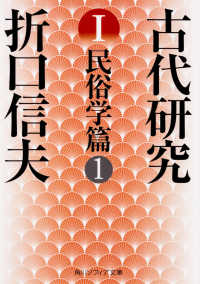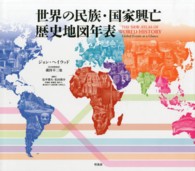Full Description
Literacymost comprehensive text in English Education for pre-service teachers. It covers the whole literacy curriculum: reading, writing, speaking, listening and viewing and illustrates how pre-service teachers can use theory in their classrooms.This accessible text is rich with practical examples, classroom scenarios, and revision questions help readers to put theory into practice. Teaching examples highlight effective assessment practices and it demonstrates how to teach to a range of learning abilities from beginning through to accomplished.
Contents
PART 1ReadingWhat is reading?A balanced approach in the Australian Curriculum: EnglishResearch and the teaching of readingThe two compatible viewsThe balanced view of reading2. Towards a Model of ReadingUnderstanding readingThe contexts in which we readThe texts we readThe knowledge we need in order to readThe skills readers useReading digital textsThe basic strategies of readingPutting it all together for effective readingSection 2: Key Elements in Learning to Read3. Oral LanguageLanguage as social practiceOral languageLearning English as an additional language or dialect (EAL/D learners)How context influences language useVocabularyOral language and learningQuestioningOral language and reading4. Word Recognition: Phonics, Phonemes and Phonemic AwarenessRecognising wordsThe writing system of EnglishPhonemes and allophonesRegular features of English orthographyThe sound system of EnglishPhonemic awareness and phonological awarenessPhonics, a vital tool for word recognitionThe school literacy program5. Comprehension: Meaning of TextThe quest for meaningKeeping things in perspectiveSkills and strategiesHow readers operateText and the locus of meaningSchools of literary criticism and meaningTeaching comprehension6. The Reader and the TextDifferent types of textsConcepts about printConstructing meaning from textText and contextHow language and image interact in textGrading or levelling textsSection 3: Planning and Teaching Reading7. Assessment in ReadingWhat is assessment?Purposes of assessmentAssessment in the school and classroomA teaching/learning cycleWhen to assess?Forms of reading assessmentOutcomes-based assessmentAuthentic assessmentReading checklists, reading profiles and cumulative assessment filesRunning recordsDiagnostic assessmentSelecting assessment strategiesAssessment and the Australian CurriculumAssessment at state and national levelsCan we improve our results in national and international assessments?8. The Effective Teaching of ReadingWhat do effective teachers do?Teaching strategies9. Learning to Read: The Child Before SchoolReading developmentLearning to readThe early literacy experienceThe role of the parent in early literacyEarly literacy in the communityIn the home, preschool classroom or library10. Learning to Read: The Early School YearsThe emergent reader: An example with Shared ReadingThe developing reader: An example with Guided ReadingThe developing reader: An example with Independent ReadingMatching books to children11. Learning to Read: The Primary School YearsThe middle primary yearsTeaching strategies for the middle primary yearsThe later primary yearsTeaching strategies for the later primary yearsReading roles in the primary yearsThe Literacy Session12. Managing Literacy in the ClassroomPlanning and programmingResourcesGrouping studentsStudents with special learning needsThe Literacy SessionPART 2: WRITING 13. The Role of WritingContext of culture and context of situationAudience and purposeWhat is writing?The power of languageThe evolution of languageMultiliteraciesEnglish nowLiteracy and computers14. The Importance of Writing in Our SocietyWhat makes writing important?Learning through writing Writing as a creative processDifferent styles of writing for different purposesOther common text-type structures15. The Writing Developmental ContinuumOverview of the writing continuumLiteracy before schoolLiteracy at schoolCharacteristics of experimental/early writingThe developing writerThe proficient writer16. GrammarWhat is grammar?Why teach grammar?Traditional and functional grammarTeaching grammarClassroom ideas for teaching grammarVerbsGrammar and language17. PunctuationWhy we need punctuationPunctuation and personal styleThe history of punctuationTeaching punctuationScope and sequence of teaching punctuationEffective literacy practicesModern punctuation18. SpellingThe teaching of spelling skillsThe stages of spelling developmentEnglish orthographyPhonics and spellingLearning styles and spelling strategiesTeaching spelling and effective classroom practicesUsing the dictionary, the thesaurus and word banksSpelling and the future19. HandwritingThe processes of handwritingTeaching handwritingFoundation and modern cursive stylesClassroom practice20. Assessment of WritingAssessment, evaluation and reportingAssessment of writing in the classroomStudent self-assessment21. Multiliteracies and TechnologyUsing ICT to enhance teaching and learningTeaching e-literacies21st-century learnersThe potential of ICT22. Teaching Writing in the ClassroomA sociolinguistic approachThe genre approachThe process approachKnowledge about languageMultiliteraciesThe importance of spoken languageThe curriculum cycleResponse: The writing conferenceStudents experiencing learning difficultiesThe importance of planningPART 3: LITERATURE23. Literature, The Curriculum and 21st Century LiteracyWhat is literature?Ideas of 'language', 'reading and 'text'Literature, language and storyChildren's literature and the literature continuumLanguage, literature and beingLiterature and digital literacy24. Starting Out: Introducing the BookThe literary toolkit: What you need to know when introducing booksGoals: Starting off on the artistic continuumThe importance of theoryThe pattern of narrative: The idea of the quest and the home-away-home story, and intertextualityPlace as part of identityYour students' journey 25. Early Childhood Literature and Engaged Play'Babies Need Books'Books as 'virtual space'An uninhibited multimodal continuum that mattersMaking it relevant for very young readers'Engaged play'26. Literary LiteraciesDigital literacyCultural literacyHow texts workDeep literacy27. Children's Literature in an Australian ContextHistorical and geographic contextsRepresentations of Australia in early children's booksBooks for young adultsAustralian poetry for childrenAustralian picturebooksBooks as ways of seeing and knowing ourselves and othersEarly writings of Indigenous storiesIndigenous writing of Indigenous storiesStories of the Asia-Pacific28. Fairy tales a Pervasive ParadigmFairytales as the province of childrenChildren's literature and oral traditionsArchetypesThe birth of the fairytale in literatureCharacteristics of the fairytaleSanitising fairytalesInterpretations of fairytalesCharacteristics of contemporary retellings29. Picture Books and PoetryVisual and verbal artVerbal and visual languages of picturebooksPicturebooks and poetic languageFormalism (and how it helps understandings of what poetry does)Summary of specific characteristics of picturebooksChildren's poetry30. Visual Literacy: Reading the World of SignsSignificance and heritageWhat is visual literacy?Interpreting visual languageThe language of gestureThe visual chronotope31. Building Community: First and Second Language Learners and Indigenous StudentsLiterature and identityFinding common groundWord magic: The power of languageTeaching Indigenous children32. A Forum: Social Issues, History and FantasyHistory and fantasy and social issuesThe environment and sustainabilityAn ethics of hope33. The Organic Classroom: A Locus of Creative Literate PracticesThe organic classEnhancing learning spaceAssessment in the organic class34. Conclusion and BeginningOsmotic research and practiceChildren's literature as theatreSoul and the ethics of hopeConnecting communitiesStarting your practiceAppendix 1: Answers to Take a TestAppendix 2: Oxford Wordlist








